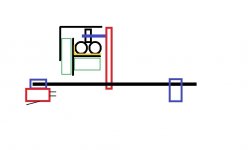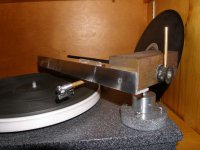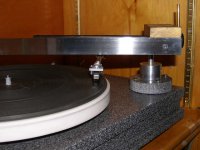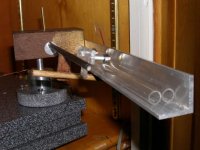Bill,
I used 1/8" thick alu L, picked up at Home Depot. 25 for 4 ft is ridiculous, I got 8 ft for 15 bucks Canadian!. It's not bendable in the length used, and as I like to do a lot in my iterations the dust cover is multi functional, it helps protect and also prevents the arm from falling off the glass tube rails.
I'm very pleased with the sounds now, took some tweaking but I've brought the bass back as this propels the music and is of utmost importance. As this thread and journey goes along its a further demystifying of the art of analog playback, and may just go to show perhaps there is still more to be said that may go against "conventional" thinking .
.
Colin
I used 1/8" thick alu L, picked up at Home Depot. 25 for 4 ft is ridiculous, I got 8 ft for 15 bucks Canadian!. It's not bendable in the length used, and as I like to do a lot in my iterations the dust cover is multi functional, it helps protect and also prevents the arm from falling off the glass tube rails.
I'm very pleased with the sounds now, took some tweaking but I've brought the bass back as this propels the music and is of utmost importance. As this thread and journey goes along its a further demystifying of the art of analog playback, and may just go to show perhaps there is still more to be said that may go against "conventional" thinking
Colin
Bill,
I used 1/8" thick alu L, picked up at Home Depot. 25 for 4 ft is ridiculous, I got 8 ft for 15 bucks Canadian!. It's not bendable in the length used, and as I like to do a lot in my iterations the dust cover is multi functional, it helps protect and also prevents the arm from falling off the glass tube rails.
I'm very pleased with the sounds now, took some tweaking but I've brought the bass back as this propels the music and is of utmost importance. As this thread and journey goes along its a further demystifying of the art of analog playback, and may just go to show perhaps there is still more to be said that may go against "conventional" thinking.
Colin,
Thanks, I never even thought of Home Depot for metal. I'll give it a go.
BillG
Colin
Prototype!!
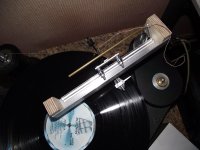
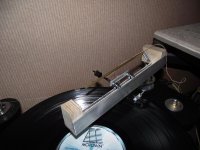
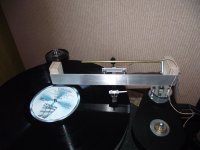
Hi Everyone
Here are pics of my latest prototype using two 6mm borosilicate rods not tubes. I had so many problems with the one tube/4 ball race versions that I'd just about given up but I thought, having owned a Cantus, that the two ball race version might just work.
Don't kid yourself about the Cantus-it was (and is) pretty crude- you don't get a lot for your £650.00 plus I can tell you.
Anyway-how does mine work? Worked perfectly from the start-and sounded superb! Next step is to do a pretty version. In the meantime this one stays where it is and I listen to some records.
By the way, I was in a store in Manchester yesterday- Fopp- sells vinyl but not as well stocked as their Edinburgh store- and they had stickers- @Vinyl is killing off MP3!)-that says it all.
Chris



Hi Everyone
Here are pics of my latest prototype using two 6mm borosilicate rods not tubes. I had so many problems with the one tube/4 ball race versions that I'd just about given up but I thought, having owned a Cantus, that the two ball race version might just work.
Don't kid yourself about the Cantus-it was (and is) pretty crude- you don't get a lot for your £650.00 plus I can tell you.
Anyway-how does mine work? Worked perfectly from the start-and sounded superb! Next step is to do a pretty version. In the meantime this one stays where it is and I listen to some records.
By the way, I was in a store in Manchester yesterday- Fopp- sells vinyl but not as well stocked as their Edinburgh store- and they had stickers- @Vinyl is killing off MP3!)-that says it all.
Chris
A note regarding the rods-they seem to be more 'dead' than tubes and when I ordered them I was slightly concerned that they would not be truly straight and would have imperfections along their length- I was wrong on both counts-highly recommended. Long time browsers of this thread will notice I've retained the same mounting arrangement as before. Very simple and makes adjustments a doddle-and very rigid in this incarnation.
Hi ChrisG,
Does that connection in the front with the Acorn nut and brass piece swivel? I'm guessing that allows you to easily up the stylus tip with the center of the LP. If so, I like it.
What material did you use for the dark egg shaped piece on the bottom?
How does the sound of the new one compare to what you recall of the Cantus?
Regards,
Hugh
Does that connection in the front with the Acorn nut and brass piece swivel? I'm guessing that allows you to easily up the stylus tip with the center of the LP. If so, I like it.
What material did you use for the dark egg shaped piece on the bottom?
How does the sound of the new one compare to what you recall of the Cantus?
Regards,
Hugh
Hi Hugh
The arm board was an idea I first noticed a few years ago and because you can swivel it around the axis it makes adjusting pivot to spindle distance very easy. Teres turntables use the same principle. This board is MDF but I have made them from marine ply and I think this is more rigid and better damped.
Regarding sound quality, this iteration is superior to the Cantus. I also had a Clearaudio Tangent arm (same principle but used a wire to slide on) and this is certainly a big improvement-perhaps that's why Clearaudio have gone on to glass? I can't rate this arm design highly enough-and I've had most of them in the past!
Regards
Chris
The arm board was an idea I first noticed a few years ago and because you can swivel it around the axis it makes adjusting pivot to spindle distance very easy. Teres turntables use the same principle. This board is MDF but I have made them from marine ply and I think this is more rigid and better damped.
Regarding sound quality, this iteration is superior to the Cantus. I also had a Clearaudio Tangent arm (same principle but used a wire to slide on) and this is certainly a big improvement-perhaps that's why Clearaudio have gone on to glass? I can't rate this arm design highly enough-and I've had most of them in the past!
Regards
Chris
A note regarding the rods-they seem to be more 'dead' than tubes and when I ordered them I was slightly concerned that they would not be truly straight and would have imperfections along their length- I was wrong on both counts-highly recommended. Long time browsers of this thread will notice I've retained the same mounting arrangement as before. Very simple and makes adjustments a doddle-and very rigid in this incarnation.
Nice going Chris,
My current model is pretty much the same as yours except for tubes instead of rods. I think that is pretty clever damping the tubes with molten glass. Cooled solid of course. Whodathunkit! All kidding aside, I'm very pleased with your success and the success of this design as well.
rgds,
BillG
Nice work Chris!,
Rods or tubes, both work equally well of course, being solid just moves any resonant frequency lower but using the alumunun L and gluing these it becomes a moot point . As long as its round, smooth and straight in this configuration I've found the absolute arm geometry has more of an impact on the sound, now do yourself a big favour and sling that counterweight lower and hear the difference .
.
Colin
Rods or tubes, both work equally well of course, being solid just moves any resonant frequency lower but using the alumunun L and gluing these it becomes a moot point . As long as its round, smooth and straight in this configuration I've found the absolute arm geometry has more of an impact on the sound, now do yourself a big favour and sling that counterweight lower and hear the difference
Colin
Nice work Chris!,
Rods or tubes, both work equally well of course, being solid just moves any resonant frequency lower but using the alumunun L and gluing these it becomes a moot point . As long as its round, smooth and straight in this configuration I've found the absolute arm geometry has more of an impact on the sound, now do yourself a big favour and sling that counterweight lower and hear the difference.
Colin
Hi Colin,
I thought I had posted a reply to this a bit ago, but I don't see it anywhere, strange. Picked up some aluminum L at Home Depot and remade the track that was not stiff enough. Huge difference, thanks for the tip. This arm is the greatest!
Can you explain what you were driving at with the absolute arm geometry comment above?
Rgds,
BillG
No problem Bill,
I stumbled on the Alu idea as its an amazing building block for a lot , but just seemed to work well here whilst allowing a nice streamlined easy to build little package.
, but just seemed to work well here whilst allowing a nice streamlined easy to build little package.
On the arm geometry, I have found too short a length of tube a detriment due to the pivot, but also placing the weight too high, those lows are dramatically improved with the low counterweight. When configuring the ideal counterweight, when placed at the end of the tube it should balance the arm perfectly, and from there adjusted to set the weight of course. The "rocking" motion that Bo Hansen talks about actually proves to track better than the see saw pivot, and this is enforced further slinging the counterweight low turning out the best bass I've heard from vinyl.
Colin
I stumbled on the Alu idea as its an amazing building block for a lot
On the arm geometry, I have found too short a length of tube a detriment due to the pivot, but also placing the weight too high, those lows are dramatically improved with the low counterweight. When configuring the ideal counterweight, when placed at the end of the tube it should balance the arm perfectly, and from there adjusted to set the weight of course. The "rocking" motion that Bo Hansen talks about actually proves to track better than the see saw pivot, and this is enforced further slinging the counterweight low turning out the best bass I've heard from vinyl.
Colin
Chris,
I wouldn't call it lightweight, but it was missing the lowest aspect of bass, and the timing vs weight of bass. But that's one aspect, with the low sling weight it just tracks better, something these vinyl trained ears have learned to respect when it's found.
Colin
I wouldn't call it lightweight, but it was missing the lowest aspect of bass, and the timing vs weight of bass. But that's one aspect, with the low sling weight it just tracks better, something these vinyl trained ears have learned to respect when it's found.
Colin
T shape carrier
I choose for a T-shape alu carrier this time . I compared the T-shape profile with L-shape profile and figure lower torsion with the T-shape , makes it a simple choice of course
The green blocks in the drawing represents the polycarbonate mounting bracket , the yellow line underneath the rods represents a rope of 3D silicon substance .. rods lightly pushed into this silicon compound .
I'm not sure yet about how to attached the alu T carrier onto the main bracket , but will figure what's best later .
The L-shape thingy is optional , just to serve as a dustcover / cartridge protector
THX Paul
I choose for a T-shape alu carrier this time . I compared the T-shape profile with L-shape profile and figure lower torsion with the T-shape , makes it a simple choice of course
The green blocks in the drawing represents the polycarbonate mounting bracket , the yellow line underneath the rods represents a rope of 3D silicon substance .. rods lightly pushed into this silicon compound .
I'm not sure yet about how to attached the alu T carrier onto the main bracket , but will figure what's best later .
The L-shape thingy is optional , just to serve as a dustcover / cartridge protector
THX Paul
Attachments
Last edited:
Hi Colin,
Picked up some aluminum L at Home Depot and remade the track that was not stiff enough. Huge difference, thanks for the tip. This arm is the greatest!
Rgds,
BillG
Hi All,
Here are some pics of my arm with 10mm tubes and aluminum L angle. Working great. Dust cover yet to come. Some of you are trying 6mm rails. Any specific reason for going to the smaller diameter?
BillG
Attachments
Last edited:
Hi All,
Here are some pics of my arm with 10mm tubes and aluminum L angle. Working great. Dust cover yet to come. Some of you are trying 6mm rails. Any specific reason for going to the smaller diameter?
BillG
Chapeau ! looks gorgious Bill !
Looks as the smaller diameter rails provides another ( not sure if that means better )
load to the bearing edge . it's only about where we want to have the bearing edge positioned ( opposed to the glass concave ) . if you ask me . can't think of anything else to be frank .
Paul
Paul,
The T is interesting but add unneccessary complexity along with puts the pivot even higher. The tube size vs bearing is still relative and is primarily driven by the width of the bearing. As such, remember back when the spacing of the 4 bearing was 5 mm for a 10 mm tube, for the 2 bearing using 2 tubes with 3mm bearing width the tubes need be around 6-7 mm for a proper channel to ride. The height of the bearings drive the choice, on 9mm bearings 12mm tube is too deep, this restricts the arm movement and we also don't want to ride the side past about 45 degrees of the bearing, there is a point where the least lateral friction will be.
Colin
The T is interesting but add unneccessary complexity along with puts the pivot even higher. The tube size vs bearing is still relative and is primarily driven by the width of the bearing. As such, remember back when the spacing of the 4 bearing was 5 mm for a 10 mm tube, for the 2 bearing using 2 tubes with 3mm bearing width the tubes need be around 6-7 mm for a proper channel to ride. The height of the bearings drive the choice, on 9mm bearings 12mm tube is too deep, this restricts the arm movement and we also don't want to ride the side past about 45 degrees of the bearing, there is a point where the least lateral friction will be.
Colin
Paul,
The T is interesting but add unneccessary complexity along with puts the pivot even higher. The tube size vs bearing is still relative and is primarily driven by the width of the bearing. As such, remember back when the spacing of the 4 bearing was 5 mm for a 10 mm tube, for the 2 bearing using 2 tubes with 3mm bearing width the tubes need be around 6-7 mm for a proper channel to ride. The height of the bearings drive the choice, on 9mm bearings 12mm tube is too deep, this restricts the arm movement and we also don't want to ride the side past about 45 degrees of the bearing, there is a point where the least lateral friction will be.
Colin
Colin, Good points you are making here. My 2 tube is built on 10mm tubes and 4mm wide 10mm outer race diameter bearings. Used these because I have them. So far there has not been a problem I'm aware of. Looking end on the tubes with a bearing seated in the channel there appears to be a pretty good fit. I think that a slightly smaller tube would be a better fit though. I've radiused and polished these bearings long ago so there should be a greater angular position effective. Must remember that the radial free play inherent in the ball bearing is where the more or less normal small warps will be accommodated. Then the traverse along the tubes will still be 4 point contacts steel to glass. You can't get much less friction than that.
Having the best bearing to channel fit will benefit more extreme warps and bearings not radiused and polished. I have not done a scale drawing yet to determine the optimum rod diameter for 4mm wide bearings. Do you have a number already, and how far out do you think my 4mm wide in 10mm tubes might be?
Thanks and rgds,
BillG
- Home
- Source & Line
- Analogue Source
- DIY linear tonearm
